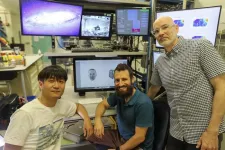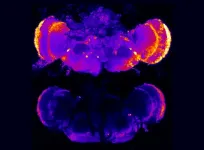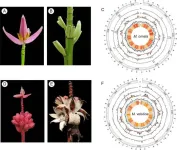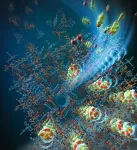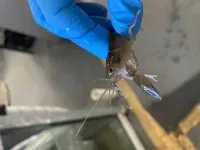Scientists at the National Institutes of Health (NIH) have uncovered a brain circuit in primates that rapidly detects faces. The findings help not only explain how primates sense and recognize faces, but could also have implications for understanding conditions such as autism, where face detection and recognition are often impaired from early childhood. The newly discovered circuit first engages an evolutionarily ancient part of the brain called the superior colliculus, which can then trigger the eyes and head to turn for a better look. This better view enables different brain areas in the temporal cortex to engage in more complex facial recognition. The study was published in the journal Neuron.
“Quick recognition of faces is a key skill in humans and other primates,” said Richard Krauzlis, Ph.D., of NIH’s National Eye Institute (NEI) and senior author of the study. “This newly discovered circuit explains how we’re able to quickly detect and look at faces, even if they first show up in the peripheral visual field where visual acuity is poor. This circuit could be what spotlights faces to help the brain learn to recognize individuals and understand complex facial expressions, helping us acquire important social interaction skills.”
In adult primates, the brain develops specialized regions of the temporal cortex called “face patches” that provide the ability to recognize and distinguish individuals by their facial features. However, facial recognition depends on fine details provided by the eye’s high acuity central vision; for us to recognize a face, we first have to look directly at it.
When babies are born, they lack the high acuity vision needed to see the fine details of faces, and the face-specific areas of the cortex don’t develop until later. Even so, babies generally orient and look at faces very early in life, suggesting that another process is in play.
These observations left scientists with several questions, including: how does the brain shift the eyes towards a face to better see fine details? What provides this face preference before the brain’s “face patches” develop? And how do the brain’s “face patches” develop the ability to understand faces in the first place?
Krauzlis and colleagues hypothesized that the superior colliculus—known to detect objects—could provide the missing link. Part of the midbrain, it tells the rest of the brain if something is present somewhere—not what the object is, but simply that it is there. It functions extremely quickly and connects directly to the motor parts of the brain, directing movements of the eyes towards objects of interest, or flinching out of the way of an object in the peripheral vision.
To test whether the superior colliculus might aid in face detection specifically, co-first authors Gongchen Yu, Ph.D., and Leor Katz, Ph.D., assembled a collection of images, including faces, biological non-face objects, like hands and arms, and other items like fruit or human-made objects. They then showed these images to adult monkeys in the monkeys’ peripheral visual field and recorded neuronal responses in the superior colliculus.
Previous studies had suggested that the detection of objects by the superior colliculus was object-agnostic, meaning that this part of the brain was just noting the presence or absence of something, without any differentiation of what that thing might be. However, in this study, Krauzlis and colleagues found that within 40 milliseconds, more than half the neurons they measured responded more strongly to images of faces compared to other types of objects. Some additional neurons eventually displayed preferences for other types of objects, but not until 100 milliseconds. In other words, the face-specific detection was much faster than detection of other objects, and was preferred by a large proportion of the measured neurons.
The researchers were also able to determine that, while the superior colliculus can receive visual information directly from the eye, this object detection process instead requires input from the early part of the visual cortex first.
Since the superior colliculus also reconnects back to the visual cortex later on in the visual processing pathway, the scientists suspect that this circuit provides a mechanism to highlight the importance of certain objects.
“We believe this face-preference circuit may actually drive the development of the brain’s more advanced facial recognition processes,” said Krauzlis. “If so, deficits in this face preference in the superior colliculus might play a role in autism.”
This study was funded by the NEI Intramural Program. In addition to co-lead authors Yu and Katz, Christian Quaia, Ph.D., and Adam Messinger, Ph.D., also contributed to the research.
Reference: Yu G, Katz LN, Quaia C, Messinger A, and Krauzlis RJ. “Short-latency preference for faces in primate superior colliculus depends on visual cortex.” Neuron. Epub Jul 2, 2024.
This press release describes a basic research finding. Basic research increases our understanding of human behavior and biology, which is foundational to advancing new and better ways to prevent, diagnose, and treat disease. Science is an unpredictable and incremental process— each research advance builds on past discoveries, often in unexpected ways. Most clinical advances would not be possible without the knowledge of fundamental basic research. To learn more about basic research, visit https://www.nih.gov/news-events/basic-research-digital-media-kit.
NEI leads the federal government’s research on the visual system and eye diseases. NEI supports basic and clinical science programs to develop sight-saving treatments and address special needs of people with vision loss. For more information, visit https://www.nei.nih.gov.
About the National Institutes of Health (NIH): NIH, the nation’s medical research agency, includes 27 Institutes and Centers and is a component of the U.S. Department of Health and Human Services. NIH is the primary federal agency conducting and supporting basic, clinical, and translational medical research, and is investigating the causes, treatments, and cures for both common and rare diseases. For more information about NIH and its programs, visit https://www.nih.gov/.
NIH…Turning Discovery Into Health®
END
